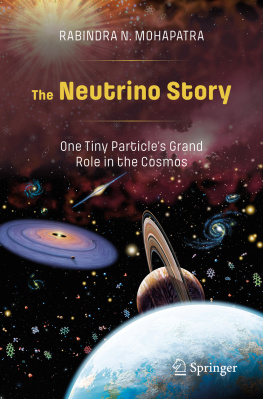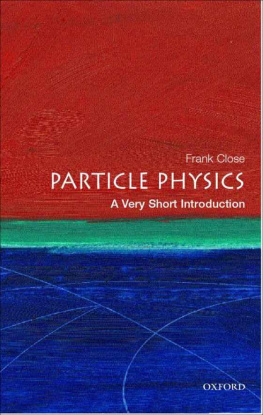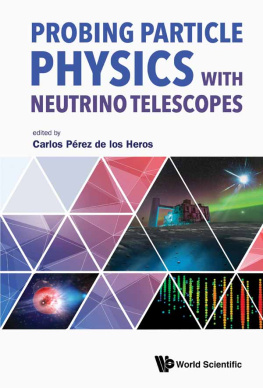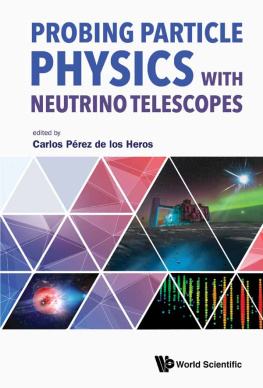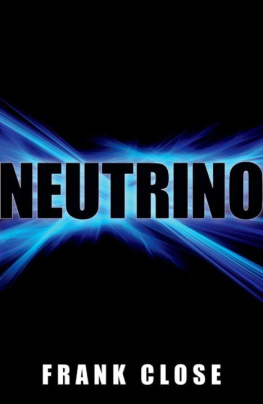Contents
Guide
Pagebreaks of the print version

EVER SMALLER
Natures Elementary Particles, from the Atom to the Neutrino and Beyond
Antonio Ereditato
Translated from the Italian by Erica Segre and Simon Carnell
Foreword by Nigel Lockyer
The MIT Press
Cambridge, Massachusetts
London, England
il Saggiatore S.r.l., Milano, 2017
English translation copyright Erica Segre and Simon Carnell
All rights reserved. No part of this book may be reproduced in any form by any electronic or mechanical means (including photocopying, recording, or information storage and retrieval) without permission in writing from the publisher.
The translation of this work has been funded by SEPS
Segretariato Europeo per le Pubblicazioni Scientifiche

Via Val dAposa 7 40123 Bologna Italy
seps@seps.it www.seps.it
Library of Congress Cataloging-in-Publication Data
Names: Ereditato, Antonio, author. | Segre, Erica, translator. | Carnell, Simon, 1962 translator. | Lockyer, Nigel, 1952 writer of foreword.
Title: Ever smaller : natures elementary particles, from the atom to the neutrino and beyond / Antonio Ereditato ; translated from the Italian by Erica Segre and Simon Carnell ; foreword by Nigel Lockyer.
Other titles: Le particelle elementari. English
Description: Cambridge, Massachusetts : The MIT Press, [2020] | Originally published as: Le particelle elementari by il Saggiatore S.r.l., Milano, 2017.
Identifiers: LCCN 2019029383 | ISBN 9780262043861 (hardcover) | ISBN 9780262358231 (ebook)
Subjects: LCSH: Particles (Nuclear physics)--History. | Particles (Nuclear physics)
Classification: LCC QC793.16 .E7413 2020 | DDC 539.7/23--dc23
LC record available at https://lccn.loc.gov/2019029383
d_r0
To Paola, who supports me, corrects and enlightens
CONTENTS
LIST OF FIGURES
John Dalton, the founder of modern atomic theory.
Joseph John Thomson, discoverer of the electron.
Thomsons cathode tube. The beam of electrons coming from the cathode is accelerated toward the anode. The latter has a slit to allow the beam to continue its path toward the fluorescent screen. The trajectory of the electrons can be bent by both an electric and a magnetic field.
Thomsons model of the atom. The negatively charged electrons are dispersed in a positively charged sphere. The total electric charge is null, guaranteeing the atoms neutrality.
Pierre Curie and Maria Skodowska Curie.
Ernest Rutherford, discoverer of the atomic nucleus and of the proton.
Lise Meitner, one of the protagonists of physics at the beginning of the twentieth century.
Diagram of the Rutherford-Geiger-Marsden experiment, which enabled the discovery of the atomic nucleus.
Comparison of the atomic models of Thomson and Rutherford. The atom is exposed to a flux ofparticles.
Sir Isaac Newton.
Albert Einstein.
Hendrik Lorentz (left) and Jules Henri Poincar, the authors of important contributions to the foundations of special relativity.
The curveshows the progression of the kinetic energy of a particle as a function of its relativistic speed. When the latter approaches, the energy of the particle increases dramatically. On the contrary, classical Newtonian energyclassincreases much less, and moreover, the speed is not limited to. Another way of interpreting this trend is that however much energy I supply to my particles, I will never reach the speed of light, or of any particle with null mass.
Energy and speed of an electron and a proton as a function of their kinetic energy, which add up to their mass values. Energy is given in multiples of electronvolts, while the speeds are given in km/s and as a fraction of the speed of light, as well. It is evident that when increasing the kinetic energy, both the electron and the proton soon become relativistic particles, namely with speeds close to
Energy spectrum of the black body radiation at different temperatures measured in kelvin: this is a temperature unit similar to degrees centigrade, but assumes that its 0 is at the so-called thermodynamic absolute zero, the lowest imaginable temperature, corresponding to nearly273 degrees centigrade. In the spectrum in the figure we have delineated the short wavelength zone (of high, ultraviolet frequency), the one corresponding to visible light (where the intensity is near maximum), and the zone of long wavelength (low frequency) relative to infrared radiation. Also shown is the classical prediction. The lack of agreement of the latter with the corresponding experimental data is striking.
Max Planck.
Niels Bohr as a young man.
Schematics of the Bohr atom. The electrons revolve in a stable fashion on orbits fixed around a nucleus of positive chargee, and on which they do not lose energy. They can jump from one atomic level to another, emitting or absorbing photons (quanta).
A radiation consisting of electromagnetic waves passes through two slits of width comparable to its wavelength. The outgoing waves interfere, producing on the screen of the detector the characteristic fringes of interference, proving the waveform nature of the radiation.
Werner Heisenberg (left) and Erwin Schrdinger, among the fathers of quantum mechanics.
Example of a wave function associated with a particle. For the sake of simplicity, lets assume thatis only a function of the space coordinate. The value of the square of the function is proportional to the probability of finding the particle at that point in space. Nevertheless, given that it is a probability and not a certainty, other positions in space are possible at the same time. In principle, the probability function extends throughout the whole universe.
Visualization of the different orbitals of the electron of a hydrogen atom, corresponding to the various solutions (eigenstates) of the Schrdinger equation. Each orbital represents a volume of space around the central proton that may be occupied by the electron. With each orbital, there is an associated probability and a specific value of the binding energy between the electron and the proton (eigenvalues).
Classical definition of the angular momentumof an electron bound to an atomic nucleus.is equal to the product of(the mass of the electron). The vector that describesis oriented perpendicularly to the rotation plane of the electron. The charge of the electron in motion generates a current, and consequently a magnetic moment, oriented in the opposite direction to that of
Description of the Stern and Gerlach experiment.
Enrico Fermi.
The Heisenberg uncertainty principle. If the photon is very energetic, the resolution of the photograph will be good (small



